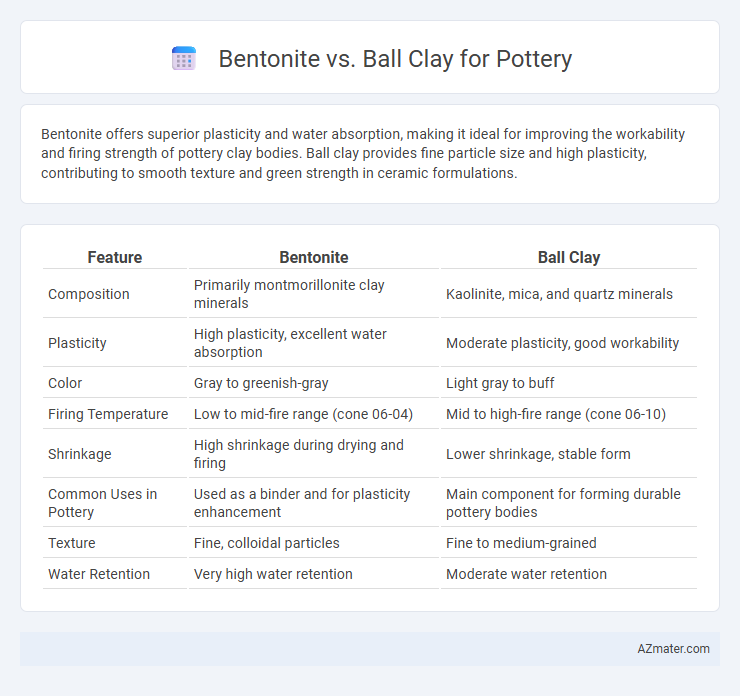Bentonite offers superior plasticity and water absorption, making it ideal for improving the workability and firing strength of pottery clay bodies. Ball clay provides fine particle size and high plasticity, contributing to smooth texture and green strength in ceramic formulations.
Table of Comparison
| Feature | Bentonite | Ball Clay |
|---|---|---|
| Composition | Primarily montmorillonite clay minerals | Kaolinite, mica, and quartz minerals |
| Plasticity | High plasticity, excellent water absorption | Moderate plasticity, good workability |
| Color | Gray to greenish-gray | Light gray to buff |
| Firing Temperature | Low to mid-fire range (cone 06-04) | Mid to high-fire range (cone 06-10) |
| Shrinkage | High shrinkage during drying and firing | Lower shrinkage, stable form |
| Common Uses in Pottery | Used as a binder and for plasticity enhancement | Main component for forming durable pottery bodies |
| Texture | Fine, colloidal particles | Fine to medium-grained |
| Water Retention | Very high water retention | Moderate water retention |
Introduction to Bentonite and Ball Clay
Bentonite is a highly absorbent clay composed mainly of montmorillonite, prized in pottery for its plasticity and ability to improve the workability of clay bodies. Ball clay consists of fine-grained kaolinite and is valued for its smooth texture, strength, and excellent binding properties in ceramics. Both clays play crucial roles in pottery, with Bentonite enhancing moisture retention and Ball clay contributing to the overall strength and plasticity of the ceramic mix.
Key Mineralogical Differences
Bentonite is primarily composed of montmorillonite, a smectite clay mineral known for its high swelling capacity and excellent plasticity, which improves casting and binding properties in pottery. Ball clay contains kaolinite, mica, and quartz, providing fine particle size and plasticity but less swelling compared to Bentonite, making it ideal for shaping and smoothing clay bodies. The distinct mineralogical composition influences water absorption, plasticity, and firing behavior, with Bentonite enhancing green strength and Ball clay aiding in workability and surface finish.
Plasticity Comparison in Pottery Applications
Bentonite offers superior plasticity compared to ball clay, making it highly effective for improving the workability and shaping of pottery clay bodies. Ball clay provides moderate plasticity with enhanced smoothness and strength, often blended with less plastic materials to balance formability and durability. The higher montmorillonite content in bentonite contributes to its exceptional swelling capacity and plasticity, ideal for specialized pottery requiring fine detailing and flexibility.
Water Absorption and Workability
Bentonite exhibits high water absorption due to its swelling properties, enhancing plasticity and improving the workability of pottery clay bodies. Ball clay has moderate water absorption with fine particles that contribute to smooth texture and excellent adhesion, aiding in shaping and molding processes. Choosing Bentonite increases moisture retention and flexibility, while Ball clay provides a balanced plasticity with reduced shrinkage during drying and firing.
Firing Temperature Ranges
Bentonite typically has a firing temperature range of cone 04 to cone 6 (approximately 1940degF to 2232degF), making it suitable for low to mid-fire pottery. Ball clay can withstand higher firing temperatures, generally ranging from cone 06 to cone 10 (about 1830degF to 2381degF), which allows for greater versatility in firing processes. Choosing between Bentonite and Ball clay depends on the desired firing temperature and the specific characteristics required for the ceramic piece.
Impact on Glaze and Color Development
Bentonite enhances glaze suspension and improves glaze adherence, resulting in a smoother, more even surface that intensifies color vibrancy and depth. Ball clay contributes to glaze plasticity and translucency, promoting subtle color shifts and a softer, more muted finish. The combination of bentonite's high swelling capacity and ball clay's fine particle size creates balanced glaze textures that optimize visual effects in pottery.
Strength and Durability of Finished Pieces
Bentonite enhances the strength and plasticity of pottery by improving particle bonding, resulting in more durable finished pieces with better resistance to cracking during drying and firing. Ball clay, known for its fine particle size and high plasticity, contributes to smooth texture and workability but does not significantly increase mechanical strength or durability compared to Bentonite. Combining Bentonite in small proportions with Ball clay often optimizes both strength and durability in ceramic pottery applications.
Cost and Availability Considerations
Bentonite is generally more affordable and widely available due to its extensive industrial uses and natural abundance, making it a cost-effective option for pottery production. Ball clay, while often more expensive, provides superior plasticity and workability but may have limited local availability, affecting overall material costs and sourcing time. Potters must weigh the balance between bentonite's economic benefits and ball clay's performance advantages based on regional supply and project budgets.
Environmental and Health Impacts
Bentonite and ball clay differ significantly in their environmental and health impacts during pottery production. Bentonite, composed mainly of montmorillonite, exhibits low toxicity but its mining can cause soil erosion and water contamination if unmanaged. Ball clay, containing kaolinite and organic matter, poses higher health risks due to dust inhalation leading to respiratory issues, highlighting the necessity for proper ventilation and dust control in pottery workshops.
Choosing the Right Clay for Your Pottery Project
Bentonite and ball clay serve distinct functions in pottery, with bentonite offering superior plasticity and water absorption, making it ideal for enhancing clay body workability and suspension in slip casting. Ball clay is prized for its fine particle size and high plasticity, contributing to strength, white firing color, and smooth texture in finished ceramics. Selecting the right clay depends on project requirements: bentonite improves suspension and plasticity, while ball clay provides strength and a refined surface finish.

Infographic: Bentonite vs Ball clay for Pottery
 azmater.com
azmater.com